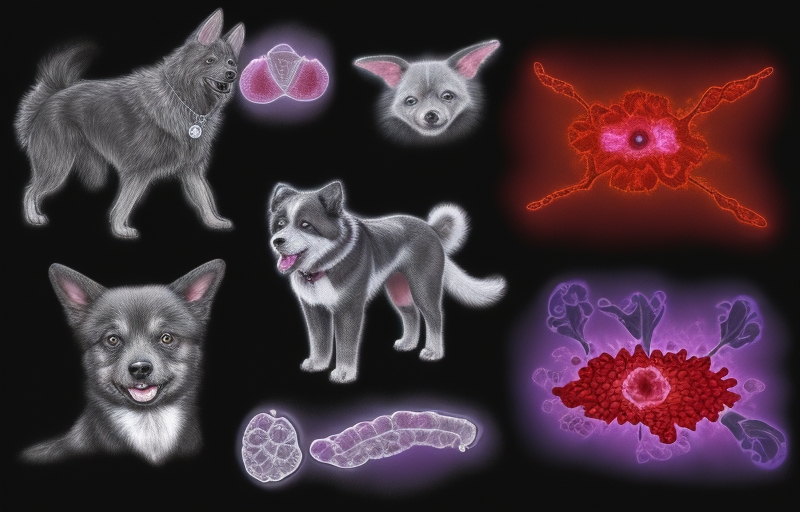Learn about spleen cancer in dogs – its symptoms, diagnosis, and treatment options. Navigate this challenging journey with your furry friend by understanding the nuances of this formidable disease.
Spleen cancer, also known as splenic hemangiosarcoma, is a formidable adversary that can affect our canine companions. Understanding the symptoms, diagnosis, and treatment options is crucial for pet owners to navigate this challenging journey with their furry friends.
Spleen Cancer in Dogs: Symptoms, Diagnosis, and Treatment

Symptoms of Spleen Cancer in Dogs:
Detecting spleen cancer in its early stages can be challenging, as symptoms may not manifest until the disease has progressed. However, vigilant pet owners may notice the following signs:
Lethargy: A sudden decrease in energy levels and enthusiasm.
Abdominal Distension: Swelling or enlargement of the abdomen, often accompanied by discomfort.
Collapse or Weakness: Episodes of fainting or weakness may occur due to internal bleeding.
Pale Gums: Anemia resulting from blood loss can lead to pale gums.
Difficulty Breathing: Accumulation of fluid in the abdomen may impede normal breathing.
Loss of Appetite and Weight Loss: Spleen cancer can affect a dog’s eating habits and result in weight loss.
If you observe any of these symptoms, prompt veterinary attention is essential for a proper diagnosis.
Diagnosis of Spleen Cancer:

Upon suspecting spleen cancer, a veterinarian will conduct a thorough examination and diagnostic tests:
- Physical Examination: A hands-on evaluation of the dog’s overall health and any noticeable abnormalities.
- Blood Tests: Analysis of blood samples to assess for anemia and other potential indicators.
- Imaging Studies: X-rays and ultrasounds can reveal the spleen’s size and shape abnormalities.
- Fine Needle Aspiration (FNA): Extracting a small sample of tissue from the spleen for microscopic examination.
- Biopsy: In some cases, a more extensive tissue sample may be required for accurate diagnosis.
A conclusive diagnosis is critical for determining the appropriate course of action.
Treatment Options for Spleen Cancer in Dogs:

The treatment approach for spleen cancer in dogs may involve a combination of surgery, chemotherapy, and supportive care:
- Surgery: Surgical removal of the affected spleen (splenectomy) is often the primary treatment. This can provide immediate relief and prevent further complications.
- Chemotherapy: Post-surgery, chemotherapy may be recommended to target any remaining cancer cells and reduce the risk of recurrence.
- Palliative Care: In cases where surgery may not be feasible, palliative care focuses on managing symptoms and improving the dog’s quality of life.
The effectiveness of treatment varies based on factors such as the cancer’s stage, the dog’s overall health, and the owner’s commitment to post-treatment care.
Conclusion
In conclusion, understanding the signs, seeking prompt veterinary attention, and exploring treatment options are vital when facing spleen cancer in dogs. Your proactive approach and the guidance of veterinary professionals can make a significant difference in your furry friend’s well-being.
Read Also: Spleen Cancer in Dogs
FAQs
Q1: Can spleen cancer in dogs be prevented?
Unfortunately, there are no specific preventive measures for spleen cancer. Regular veterinary check-ups and early detection can, however, improve treatment outcomes.
Q2: How long does it take for a dog to recover from spleen cancer surgery?
Recovery time varies, but most dogs can resume normal activities within a few weeks. Follow-up care and adherence to post-surgery instructions are crucial for a smooth recovery.
Q3: Are there breed predispositions for spleen cancer?
Certain breeds, such as German Shepherds, Golden Retrievers, and Labrador Retrievers, are more prone to spleen cancer. However, it can affect dogs of any breed or mix.
Q4: Is chemotherapy necessary after spleen removal?
While not mandatory, chemotherapy is often recommended post-surgery to target any remaining cancer cells and reduce the risk of recurrence.

1 thought on “Spleen Cancer in Dogs: Symptoms, Diagnosis, and Treatment”